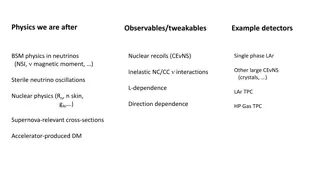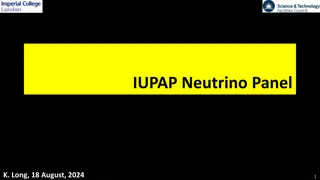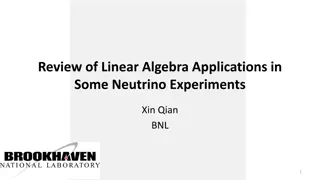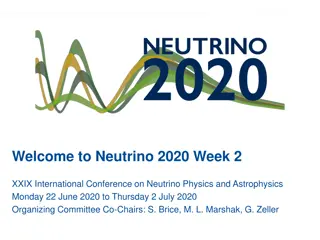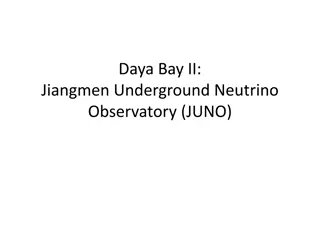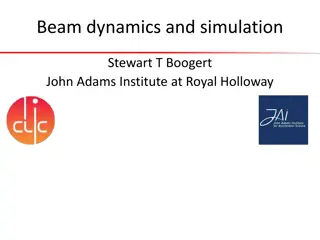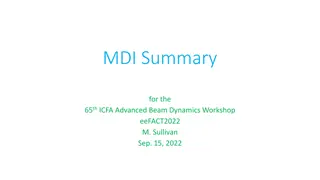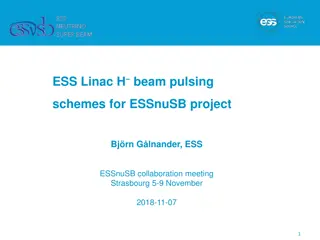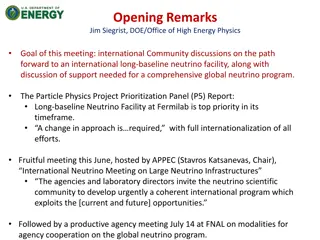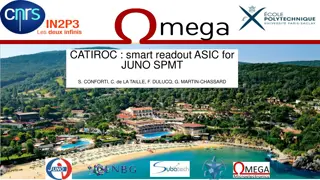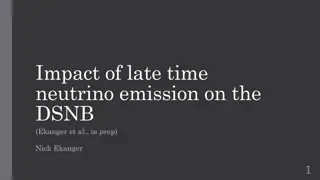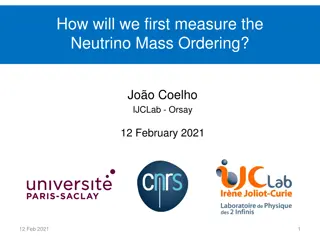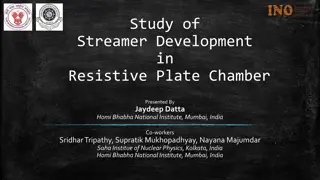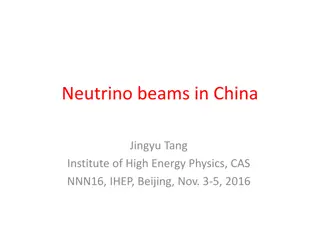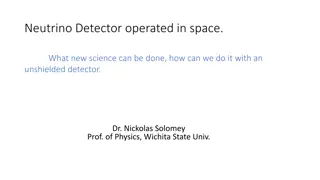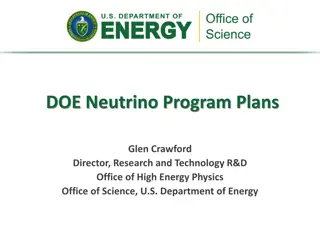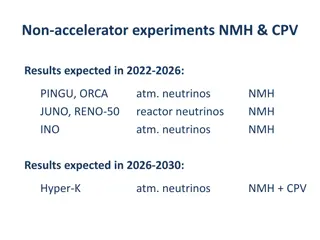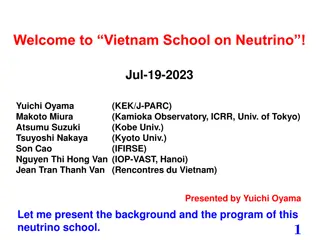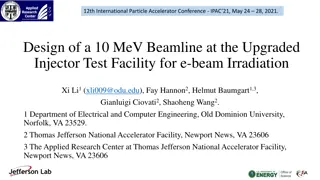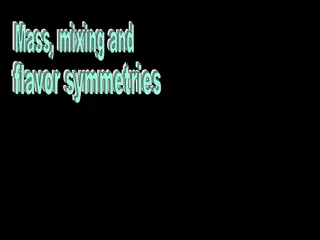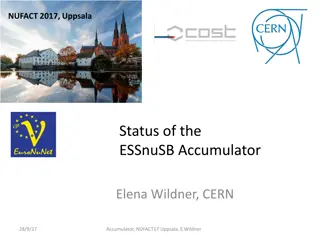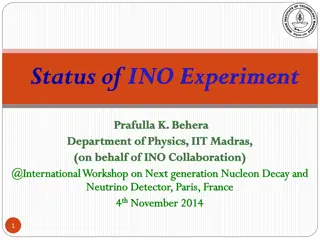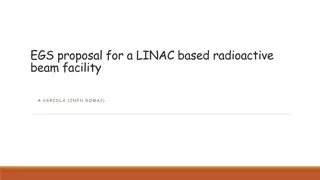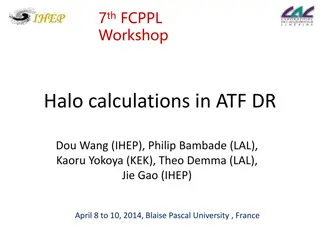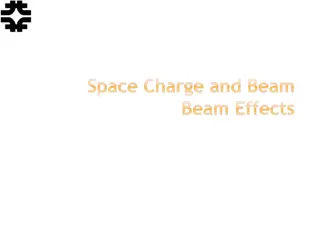Neutrino Physics and Beyond with Observables and Detectors
Delve into the realm of neutrino physics, nuclear recoils, and other phenomena like sterile neutrino oscillations using detectors such as BSM and single-phase LAr inelastic NC/CC interactions. From NSI to Supernova-relevant cross-sections and accelerator-produced DM, this research journey covers a w
0 views • 5 slides
Evolution of the ICFA Neutrino Panel: A Journey Towards International Collaboration
The ICFA Neutrino Panel, established in 2013, has made significant contributions to the accelerator-based neutrino program. Through consultations with global neutrino communities and international meetings, the Panel has crafted a roadmap for future programs, emphasizing the complementarity of exper
1 views • 12 slides
Neutrino Detectors for NuStorm: Physics Goals and Detector Requirements
Physics goals for neutrino detectors in the NuStorm project include measuring exclusive neutrino cross sections, supporting long baseline programs, searching for sterile neutrinos, and improving measurements. Detector requirements involve reconstructing neutrino interactions, providing charge and pa
0 views • 21 slides
Neutrino Interactions with Liquid Argon at DUNE Near Detector Complex
The Deep Underground Neutrino Experiment (DUNE) aims to study neutrino oscillations using high-precision measurements with detectors like the Near Detector complex located downstream of the neutrino beam. Components such as ND-LAr and SAND play crucial roles in scanning energy spectra. SAND, a perma
1 views • 16 slides
Linear Algebra Applications in Neutrino Experiments
Linear Algebra plays a crucial role in various neutrino experiments, enabling solutions in weighted least squares, energy estimation in EXO-200, and signal processing in LArTPC detectors. From Cartesian coordinates to minimizing uncertainties, linear algebra techniques contribute significantly to da
0 views • 38 slides
Neutrino 2020: International Conference Highlights
Explore the diverse experiences at Neutrino 2020, featuring plenary talks, poster sessions, virtual reality interactions, and engaging discussions via Slack. Learn about the block schedule, additional talks, and the online conference format with Q&A opportunities and poster competitions. Don't miss
1 views • 8 slides
Daya Bay II: Jiangmen Underground Neutrino Observatory (JUNO)
Delve into the Daya Bay II project, encompassing the Jiangmen Underground Neutrino Observatory (JUNO), which secured a substantial funding commitment from the Chinese government. With construction slated to commence in 2015 and the first physics data expected by 2020, this ambitious venture has garn
0 views • 13 slides
Advancements in Beam Dynamics and Simulation at John Adams Institute
Explore the latest research highlights in beam dynamics and simulation conducted by Stewart T. Boogert at the John Adams Institute in collaboration with Royal Holloway. Learn about the groundbreaking work in wakefield measurement, achieving a beam size of 65 nm, development of beam delivery simulati
2 views • 15 slides
Critical Issues in CLIC Drive Beam by Working Group 6 at LCWS11
Issues identified in the CLIC Drive Beam project include RF stability and reliability, beam current stability, RF deflectors in combiner rings, synchrotron radiation power, beam dynamics, operability concerns, machine protection, and beam synchronization challenges. Key areas requiring attention inc
1 views • 5 slides
Beam-beam Effects in Future Hadron Colliders Workshop
Explore the beam-beam effects in the SPPC and future hadron colliders, presented at the International Workshop on High Energy Circular Electron-Positron Colliders. The workshop covers weak-strong beam-beam simulations, collision models, and parameter values for the SPPC. Detailed discussions on the
0 views • 32 slides
Analysis of Beam Tracking in IEEE 802.11-19/0007r0 Document
The document "January 2019.doc: IEEE 802.11-19/0007r0" discusses the necessity of beam tracking in the 11md draft. It explores whether beam tracking should be mandatory or optional and provides insights into DMG beam tracking procedures for both TX and RX in wireless communication. The document emph
3 views • 11 slides
Revolutionizing Oral Care with Beam Connected Toothbrush and Insurance Plan
Beam Technologies offers the Beam Brush, a smart toothbrush that integrates with a dental insurance plan to promote preventative oral care, reduce costs, and provide valuable insights on oral health. The Beam Brush and accompanying app track and reward good oral hygiene habits, detect oral diseases,
0 views • 5 slides
Advanced Beam Diagnostics and Control Systems in Beam Physics
Cutting-edge detector technologies like KAPTURE and KALYPSO are revolutionizing beam diagnostics with ultra-fast Terahertz detectors and advanced line-camera systems. The POF III and POF IV projects focus on extreme beam control and diagnostics, aiming to probe femto-scale dynamics of relativistic p
0 views • 8 slides
Overview of Electron/Positron Injector Linac Upgrades at KEK
The recent status of the Electron/Positron Injector Linac at KEK, presented by Kazuro Furukawa, highlights the mission to achieve 40 times higher luminosity in the SuperKEKB collider. The upgrades include low emittance, low energy spread injection beams with higher beam current, new high-current pho
0 views • 23 slides
Ion Beam Intensity Enhancement Through Electron Heating in Collider Experiments
The study discusses electron heating of ions in collider experiments at the Collider V. ParkhomchukBINP facility in Novosibirsk. It explores the effects of electron cooling on ion beams, ion beam oscillations, losses, and ion beam intensity enhancement. Various factors such as ion charge, classical
1 views • 9 slides
Highlights of the 65th ICFA Advanced Beam Dynamics Workshop
The 65th ICFA Advanced Beam Dynamics Workshop featured insightful presentations on high currents, luminosity, and beam behaviors. Topics included beam pipe scrubbing, non-gaussian beam tails, and detector backgrounds. Presenters discussed progress in FCCee design, focus magnets, and beampipe concept
1 views • 32 slides
Achieving High Average Beam Polarization in Particle Colliders
Detailed discussion on achieving high average beam polarization in particle colliders like CEPC, focusing on longitudinal polarized colliding beams, beam polarization requirements, basic formulas, and strategies for maintaining beam polarization during physics runs. Emphasis on scenarios involving s
2 views • 16 slides
ESSnuSB Project - Linac Upgrade for Neutrino Beam Generation
Explore the ESSnuSB project's linac upgrade featuring beam pulsing schemes and modifications, aiming to provide an additional 5 MW of beam power for neutrino generation. The upgrade options, pulse structure, beam parameters at 2.5 GeV, and different pulsing schemes are detailed with images and descr
2 views • 10 slides
Electron Lenses in Particle Accelerators: Advancements and Applications
Explore the use of electron lenses in particle accelerators for space-charge compensation, Landau damping, halo collimation, and beam-beam compensation. Learn about their history, applications in Tevatron and RHIC colliders, and current research areas. Electron lenses have shown promise in enhancing
1 views • 44 slides
Update on UE Beam Assumption for RRM Test Cases in 3GPP Meetings
The latest developments in 3GPP meetings regarding UE beam assumption for RRM test cases are outlined. Discussions include the need for UE beam type assumptions, updates to test cases for FR2, and upcoming presentations focusing on specific test cases and beam assumptions per test group. Test purpos
0 views • 9 slides
International Efforts for Long-Baseline Neutrino Facility
International discussions are underway regarding the establishment of an international long-baseline neutrino facility and the need for comprehensive global support. The P5 report emphasizes the urgency of forming a new international collaboration to design and execute a Long-Baseline Neutrino Facil
0 views • 4 slides
Advancements in CATIROC Technology for Neutrino Observatories
CATIROC is a smart readout ASIC developed for experiments like JUNO, a neutrino observatory. With applications in photon counting, energy measurement, and data processing, CATIROC offers advanced features such as charge and time measurements, digital data conversion, and trigger outputs for improved
0 views • 20 slides
Late-Time Neutrino Emission Impact on DSNB Study
Explore the implications of late-time neutrino emission on the Diffuse Supernova Neutrino Background (DSNB) through core collapse supernovae simulations. The research delves into the dynamics of neutrino emission in different phases of supernova events and its relevance to understanding the DSNB.
1 views • 15 slides
Neutrino Mass Ordering and Its Implications
Delve into the world of neutrino mass ordering, from the methods of measurement to the significance of Normal versus Inverted Ordering. Discover how determining the mass hierarchy impacts our understanding of physical interactions, cosmology, decay processes, and more. Uncover the latest updates on
0 views • 25 slides
Overview of Mu2e Slow Extraction Workshop at Fermilab by Vladimir Nagaslaev
This content discusses the Mu2e project at Fermilab, focusing on slow extraction techniques for beam delivery. It covers beam facilities, characteristics of Muon Campus, design requirements, beam losses, new MARS simulations, and losses in the extraction beam line. Details include beam kinetics, spi
1 views • 17 slides
Study of Streamer Development in RPC for Neutrino Observatory Experiment
India-Based Neutrino Observatory (INO) aims to study neutrino properties using experiments like ICAL with RPCs. This work focuses on simulating streamer probability in RPCs using eco-friendly gas mixtures to replace R134a. Various simulation tools are employed to model streamer behavior and primary
0 views • 14 slides
Overview of Neutrino Beams in China: MOMENT Study Progress and Potential
The MOMENT study, initiated in 2013 in China, focuses on muon-decay medium baseline neutrino beam facility development. Using a Continuous Wave (CW) proton linac, the project aims to achieve 15 MW beam power for neutrino cross-section measurements and CP phase study. Recent progress includes the suc
1 views • 28 slides
Neutrino Science in Space with Unshielded Detector - Opportunities and Innovations
The deployment of a neutrino detector in space presents a unique opportunity to conduct groundbreaking scientific research, leveraging the intense neutrino flux closer to the Sun. Key areas of focus include studying rare fusion neutrinos, observing neutrino oscillations during spacecraft transitions
1 views • 11 slides
Neutrino Program Plans and Recommendations by U.S. Department of Energy
The U.S. Department of Energy's Neutrino Program outlines significant changes and recommendations to pursue neutrino mass physics. These plans include international collaboration, short and long-baseline experiments at Fermilab, and the selection of small-scale experiments to address beyond the thre
0 views • 9 slides
Overview of CAIN Particle Tracking Code for High-Energy Colliders
CAIN is a particle tracking code used for high-energy collider simulations since 1984. Initially named ABEL, it evolved to include beam-laser interactions for gamma-gamma colliders. The code, written in FORTRAN 90, handles beam-beam and external fields, with a structure where all particles are store
0 views • 17 slides
Overview of Non-Accelerator Neutrino Experiments and Programs
Non-accelerator experiments in the field of neutrino physics are expected to yield significant results between 2022 and 2030. Projects like PINGU, ORCA, JUNO, RENO-50, INO, Hyper-K, and DUNE aim to study neutrino mass hierarchy, CP violation, and non-oscillation phenomena. The design and constructio
0 views • 10 slides
Vietnam Neutrino School Overview
Vietnam School on Neutrino is an annual event started in 2017 to promote experimental neutrino physics in Vietnam. Led by Prof. Jean Tran Thanh Van, the school focuses on lectures, software and hardware training, group works, and excursions. With a mix of students from various countries, the aim is
0 views • 7 slides
Design of a 10 MeV Beamline for E-beam Irradiation at UITF Wastewater Facility
This paper discusses the design of a 10 MeV beamline at the Upgraded Injector Test Facility for electron beam irradiation, focusing on wastewater treatment for environmental restoration. The use of electron beam irradiation is highlighted as an effective method to remove pollutants like 1,4 dioxane
0 views • 9 slides
Neutrino Mass, Mixing, and Flavor Symmetries
Neutrino physics involves studying mass, mixing, and flavor symmetries, which present new challenges when dealing with multiple neutrinos. The discussion includes neutrino states, mixing matrices, flavor content, vacuum mixing, standard parametrization, mixing angles, global fits, and the Tri-bimaxi
0 views • 59 slides
Challenges and Design of High-Intensity Accumulator for Neutrino Experiments
The presentation discusses the challenges faced in designing an accumulator for high-intensity particle beams in neutrino experiments at ESS Lund, with a focus on beam loss management, injection efficiency, and intense beam physics issues. The design considerations include beam holding capacity, bea
1 views • 30 slides
Status of INO Experiment
Brief history of atmospheric neutrino experiments leading to the creation of India Based Neutrino Observatory for further particle and astroparticle physics research. The facility aims to probe neutrino properties using underground laboratory and complementary efforts worldwide, with ICAL capability
0 views • 23 slides
LINAC-Based Radioactive Beam Facility Proposal
Proposal for a LINAC-based radioactive beam facility at VARIOLA (INFN ROMA1), aiming to serve the needs of the Romanian research community with added value in the present research framework. The project constraints focus on utilizing existing elements, minimizing hardware modifications, and ensuring
0 views • 16 slides
Charge Spreading Advancements in T2K Neutrino Experiment
New TPCs with resistive Micromegas technology for T2K near detector upgrade are enhancing neutrino beam monitoring and cross-section measurements. These upgrades focus on improving point resolution and efficiency with the introduction of finely segmented targets. The utilization of DLC in Micromegas
0 views • 22 slides
ATF Damping Ring Beam Halo Generation and Distribution Study
Explore the generation and distribution of beam halo in ATF damping ring, investigating main sources like beam-gas scattering and intrabeam scattering. Calculations, theory foundation, and cross-section analysis are discussed, along with beam distribution due to beam-gas interactions at different pr
0 views • 22 slides
Understanding Space Charge and Beam Beam Effects in Accelerators
Explore the impact of space charge and beam beam effects on particle distribution in accelerators, with insights on field calculations, Amperes' Law, and beam component analysis. Learn about classical radius, tuneshift considerations, and practical examples from Fermilab Booster. Discover strategies
0 views • 12 slides
